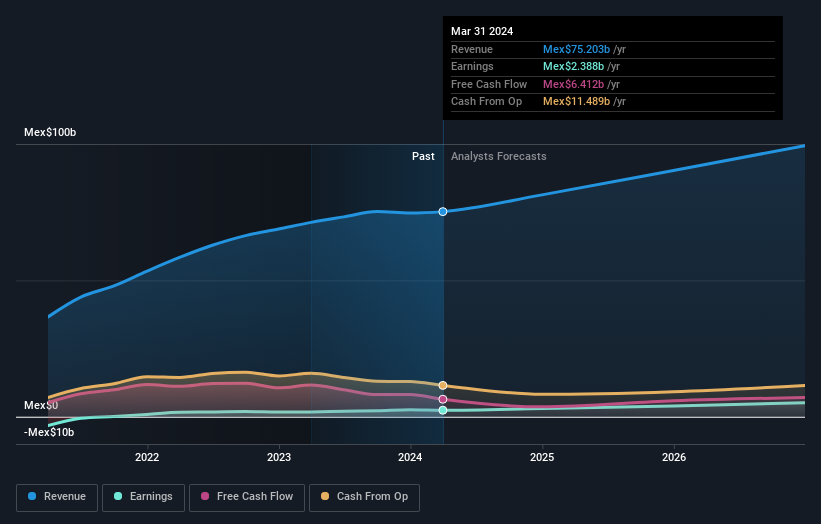- Mexico
- /
- Hospitality
- /
- BMV:ALSEA *
Owning 39% in Alsea, S.A.B. de C.V. (BMV:ALSEA) means that insiders are heavily invested in the company's future
Key Insights
- Alsea. de's significant insider ownership suggests inherent interests in company's expansion
- 52% of the business is held by the top 6 shareholders
- 27% of Alsea. de is held by Institutions
Every investor in Alsea, S.A.B. de C.V. (BMV:ALSEA) should be aware of the most powerful shareholder groups. The group holding the most number of shares in the company, around 39% to be precise, is individual insiders. Put another way, the group faces the maximum upside potential (or downside risk).
With such a notable stake in the company, insiders would be highly incentivised to make value accretive decisions.
Let's take a closer look to see what the different types of shareholders can tell us about Alsea. de.
Check out our latest analysis for Alsea. de

What Does The Institutional Ownership Tell Us About Alsea. de?
Institutions typically measure themselves against a benchmark when reporting to their own investors, so they often become more enthusiastic about a stock once it's included in a major index. We would expect most companies to have some institutions on the register, especially if they are growing.
Alsea. de already has institutions on the share registry. Indeed, they own a respectable stake in the company. This suggests some credibility amongst professional investors. But we can't rely on that fact alone since institutions make bad investments sometimes, just like everyone does. When multiple institutions own a stock, there's always a risk that they are in a 'crowded trade'. When such a trade goes wrong, multiple parties may compete to sell stock fast. This risk is higher in a company without a history of growth. You can see Alsea. de's historic earnings and revenue below, but keep in mind there's always more to the story.

Hedge funds don't have many shares in Alsea. de. Our data shows that Cosme Torrado Martinez is the largest shareholder with 12% of shares outstanding. In comparison, the second and third largest shareholders hold about 12% and 12% of the stock. Two of the top three shareholders happen to be Chief Executive Officer and Chairman of the Board, respectively. That is, insiders feature higher up in the heirarchy of the company's top shareholders.
On further inspection, we found that more than half the company's shares are owned by the top 6 shareholders, suggesting that the interests of the larger shareholders are balanced out to an extent by the smaller ones.
Researching institutional ownership is a good way to gauge and filter a stock's expected performance. The same can be achieved by studying analyst sentiments. There are a reasonable number of analysts covering the stock, so it might be useful to find out their aggregate view on the future.
Insider Ownership Of Alsea. de
The definition of an insider can differ slightly between different countries, but members of the board of directors always count. Management ultimately answers to the board. However, it is not uncommon for managers to be executive board members, especially if they are a founder or the CEO.
Insider ownership is positive when it signals leadership are thinking like the true owners of the company. However, high insider ownership can also give immense power to a small group within the company. This can be negative in some circumstances.
Our most recent data indicates that insiders own a reasonable proportion of Alsea, S.A.B. de C.V.. It has a market capitalization of just Mex$57b, and insiders have Mex$23b worth of shares in their own names. That's quite significant. Most would be pleased to see the board is investing alongside them. You may wish to access this free chart showing recent trading by insiders.
General Public Ownership
The general public, who are usually individual investors, hold a 34% stake in Alsea. de. While this group can't necessarily call the shots, it can certainly have a real influence on how the company is run.
Next Steps:
It's always worth thinking about the different groups who own shares in a company. But to understand Alsea. de better, we need to consider many other factors. To that end, you should be aware of the 1 warning sign we've spotted with Alsea. de .
But ultimately it is the future, not the past, that will determine how well the owners of this business will do. Therefore we think it advisable to take a look at this free report showing whether analysts are predicting a brighter future.
NB: Figures in this article are calculated using data from the last twelve months, which refer to the 12-month period ending on the last date of the month the financial statement is dated. This may not be consistent with full year annual report figures.
New: Manage All Your Stock Portfolios in One Place
We've created the ultimate portfolio companion for stock investors, and it's free.
• Connect an unlimited number of Portfolios and see your total in one currency
• Be alerted to new Warning Signs or Risks via email or mobile
• Track the Fair Value of your stocks
Have feedback on this article? Concerned about the content? Get in touch with us directly. Alternatively, email editorial-team (at) simplywallst.com.
This article by Simply Wall St is general in nature. We provide commentary based on historical data and analyst forecasts only using an unbiased methodology and our articles are not intended to be financial advice. It does not constitute a recommendation to buy or sell any stock, and does not take account of your objectives, or your financial situation. We aim to bring you long-term focused analysis driven by fundamental data. Note that our analysis may not factor in the latest price-sensitive company announcements or qualitative material. Simply Wall St has no position in any stocks mentioned.
About BMV:ALSEA *
Undervalued with high growth potential.
Similar Companies
Market Insights
Community Narratives



